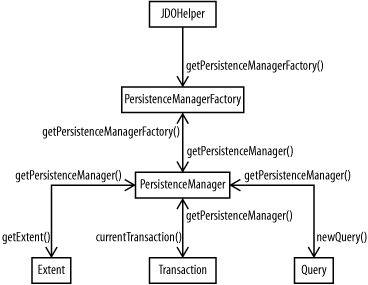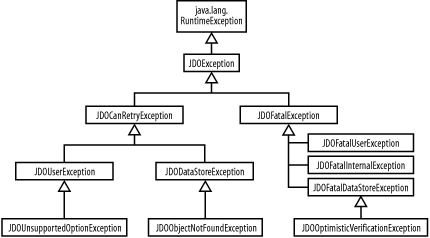2.1 The
javax.jdo Package
The javax.jdo package contains all the interfaces
you should use:
It also contains the JDOHelper class and a set of
exception classes.
This is the complete set of JDO application interfaces! JDO has a
relatively small API, allowing you to learn it quickly and become
productive applying it. JDO uses your Java classes as the data model
for representing and managing data, which is major contributing
factor in its simplicity and ease of use.
Every method in each of these interfaces is described somewhere in
this book. We introduce basic JDO concepts first and gradually
progress to more advanced topics. Semantically related methods are
often covered in the same section, but coverage of the methods for a
particular interface is usually dispersed throughout the text. Appendix C provides the signature for every method in
each interface. The index provides a reference to each place in the
book where a method is covered. Here's a brief
description of each interface in the package:
- PersistenceManager
-
PersistenceManager is your primary interface when
using JDO. It provides methods to create query and transaction
objects, and it manages the lifecycle of persistent instances. Each
chapter introduces a few PersistenceManager
methods. The interface is used for the basic and advanced features in
JDO.
- PersistenceManagerFactory
-
The PersistenceManagerFactory is responsible for
configuring and creating PersistenceManager
instances. It represents the particular JDO implementation you are
using; it has methods to determine the properties and optional
features the implemention supports.
PersistenceManagerFactory also provides methods to
control property values used to establish a datastore connection and
affect the configuration of the runtime environment in which the
PersistenceManager instances run; these methods
are covered in Chapter 7.
- JDOHelper
-
JDOHelper is a class that provides several static
utility methods. As shown in Chapter 1, it is used
to construct a PersistenceManagerFactory instance
from a Properties object. It also provides methods
to interrogate the lifecycle state of instances (covered in Chapter 11).
- Transaction
-
The Transaction interface provides methods to
manage the demarcation (begin and commit/rollback) of transactions.
Chapter 7 covers these methods in detail. Each
PersistenceManager instance has one associated
Transaction instance, accessible via
currentTransaction(
). Transaction also has methods for
controlling the values of transaction options.
- Extent
-
The Extent interface is used to access all the
instances of a class (and, potentially, its subclasses). You acquire
an Extent by calling the
getExtent(
) method of a PersistenceManager. You
can either iterate over the Extent or use it to
perform a query. Chapter 8 covers the
Extent interface in detail.
- Query
-
You use the Query interface to perform queries. A
Query instance has several components, and the
interface provides methods to specify a value for each of them. The
query evaluates a filter expressed in the JDO Query Language (JDOQL).
Chapter 9 covers the Query
interface in detail.
- InstanceCallbacks
-
The InstanceCallbacks interface provides a means
for you to specify some behavior to perform when specific lifecycle
events occur in an instance of a persistent class. The interface
defines methods that are called on an instance when it undergoes a
lifecycle change. A persistent class must implement the
InstanceCallbacks interface for these methods to
be called. Chapter 12 and Chapter 13 cover this interface and its callback methods.
Figure 2-1 illustrates the relationships among the
JDO interfaces and shows the method used to create or navigate to the
related instance.

Some methods in the JDO interfaces are used to perform advanced
operations. Some applications may use advanced JDO features, but a
large percentage of the software in such applications will use only a
small subset of JDO's methods. The following list of
core JDO interfaces provide the majority, and, in many cases, all of
the functionality necessary to use JDO:
We demonstrated the use of most of these methods in Chapter 1. The fact that this list of interfaces is so
small is a major reason JDO is so easy to use.
Your persistent classes can have fields of the following standard
Java types: byte, short,
char, int,
long, float,
double, Byte,
Short, Character,
Integer, Long,
Float, Double,
BigInteger, BigDecimal,
String, Date,
Set, and HashSet. Your
persistent classes can contain references to both persistent and
transient classes. You can also define inheritance hierarchies and
have references that refer to instances of subclasses. JDO directly
supports the persistence of your Java object models, without
requiring you to learn and use any new datatypes.
2.1.1 JDO Exception Classes
There are many opportunities for a component to fail that are not
under the application's control. A JDO
implementation is often built as a layer on an underlying datastore
interface, which itself might use a layered protocol to another tier
in a system's architecture. The source of an error
may be caused by the application, the JDO implementation, or the
underlying datastore on one or several tiers in an architecture.
JDO's exception philosophy is to treat all
exceptions as
runtime exceptions. This preserves the transparency of
JDO's interface as much as possible, allowing you to
choose which specific exceptions to catch based upon your application
requirements.
JDO exceptions fall into several broad categories, each of which is
treated separately:
Program errors that can be corrected and retried Program errors that cannot be corrected, because the state of
underlying components has been changed and cannot be undone Logic errors internal to the JDO implementation, which should be
reported to the vendor's technical support Errors in the underlying datastore that can be corrected and retried Errors in the underlying datastore that cannot be corrected, due to a
failure of the datastore or the communication path to the datastore
JDO uses several interfaces external to the JDO API itself (e.g., the
Collection interfaces). An exception that results
from using one of these interfaces is used directly, without
modification. If an exception occurs in the underlying datastore, the
exception is wrapped inside a JDO exception. If your application
causes a JDO exception, the exception contains the reason it was
thrown.
Figure 2-2 illustrates the JDO exception
inheritance hierarchy. The base exception class is called
JDOException,
and it extends
RuntimeException.
The classes that extend JDOException divide
exceptions into those that are fatal and those that can be retried.
The hierarchy is then extended based on the original source of the
error. JDO exceptions are serializable.

This chapter provides complete coverage of the exception classes in
the book. Let's examine each exception class:
- JDOException
-
JDOException is the base class for all JDO
exceptions. Since it is a subclass of
RuntimeException,
JDO exceptions do not need to be declared or caught. The class
includes a toString( ) method that returns a value
indicating the nature of the exception. If the
PersistenceManager is internationalized, the
descriptive string is also internationalized.
If an exception is relative to a specific instance of one of your
classes, you can call
getFailedObject(
) to retrieve the instance. If the exception is caused by
multiple instances, then each instance is wrapped in its own
exception instance, and all of these exceptions are nested inside an
exception that is thrown to the application. Such nested exceptions
can occur as a result of multiple underlying exceptions or from an
exception that involves multiple instances. You may have called a
method that accepts a collection of instances, and multiple instances
in the collection failed the operation. Or you may have called
commit( ) in Transaction, which
can fail on instances accessed during the transaction. In these
cases, you can call
getNestedExceptions(
) on the thrown exception to retrieve the array of nested
exceptions. Each nested exception may have its own failed instance,
returned by
getFailedObject(
).
JDOException contains all of the functionality
needed to access information about the exception. Its subclasses do
not add any additional functionality to access information; they are
used strictly to categorize the type of exception and provide a means
for the application to catch and respond to an exception differently,
based on its type and associated category.
- JDOCanRetryException
-
This is the base class for exceptions that can be retried.
- JDODataStoreException
-
This is the base class for datastore exceptions that can be retried.
- JDOUserException
-
This is the base class for exceptions caused by your application that
can be retried.
- JDOUnsupportedOptionException
-
This exception is thrown if you attempt to use an optional JDO
feature that the implementation does not support.
- JDOObjectNotFoundException
-
This exception occurs if an attempt is made to fetch an object that
does not exist in the datastore.
- JDOFatalException
-
This is the base class for exceptions that are fatal and cannot be
retried. Usually, when this exception is thrown, the transaction has
been rolled back and should be abandoned.
- JDOFatalInternalException
-
This is the base class for all failures within the JDO implementation
itself. There is no action that can be taken to recover from this
exception. You should report this exception to the JDO vendor for
corrective action.
- JDOFatalUserException
-
This is the base class for exceptions caused by your application that
cannot be retried.
- JDOFatalDataStoreException
-
This is the base class for fatal datastore exceptions. When this
exception is thrown, the transaction has been rolled back. The cause
of the exception may be a connection timeout, an unrecoverable media
error, an unrecoverable concurrency conflict, or some other cause
outside of the application's control.
- JDOOptimisticVerificationException
-
A verification step (which is described in Chapter 15) is performed on all instances that are new,
modified, or deleted when you make a call to commit an optimistic
transaction. If any instances fail this verification step, a
JDOOptimisticVerificationException is thrown. It
contains an array of nested exceptions; each nested exception
contains an instance that failed verification. More details on
optimistic transactions and the verification step can be found in
Chapter 15.
|

